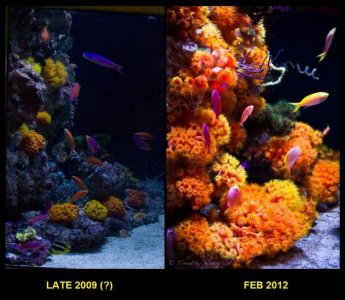Nutrient recycling of phosphate by cynobacteria
Nutrient recycling of phosphate by cynobacteria
In nature, through natural evolution and survival of the fittest, energy is conserved. Meaning that nature uses biology and chemistry very efficiently. Multiple nutrient pathways provide complex food webs to feed tank inhabitants. It all starts with the bugs (microbial overlords, bacteria). Just ask the Martians in War of the Worlds if bacteria are important. If it weren't for blue/green cynobacteria Earth's athmosphere would still be methane gas.
Let us focus on cynobacteria. In the ocean enviroment, nitrogen as a free gas is converted into nitrate in a process called nitrogen fixation. In our reef tanks, inorganic phosphate in the form of calcium phosphate is converted into organic phosphate. Now you know why the water can be void of nutrients but cyno can still thrive.
When bacteria grow they absorb nutrients through their cell membrane. This includes nitrates and phosphates. Industrial waste water treatment R&D discovered that if bacteria were stressed with low oxygen levels, then phosphates were uptaken at a higher phosphate to nitrate ratio then when not stressed.
Nutrient recycling of phosphate by cynobacteria
In nature, through natural evolution and survival of the fittest, energy is conserved. Meaning that nature uses biology and chemistry very efficiently. Multiple nutrient pathways provide complex food webs to feed tank inhabitants. It all starts with the bugs (microbial overlords, bacteria). Just ask the Martians in War of the Worlds if bacteria are important. If it weren't for blue/green cynobacteria Earth's athmosphere would still be methane gas.
Let us focus on cynobacteria. In the ocean enviroment, nitrogen as a free gas is converted into nitrate in a process called nitrogen fixation. In our reef tanks, inorganic phosphate in the form of calcium phosphate is converted into organic phosphate. Now you know why the water can be void of nutrients but cyno can still thrive.
When bacteria grow they absorb nutrients through their cell membrane. This includes nitrates and phosphates. Industrial waste water treatment R&D discovered that if bacteria were stressed with low oxygen levels, then phosphates were uptaken at a higher phosphate to nitrate ratio then when not stressed.

